As an Amazon Associate, we earn from qualifying purchases with no additional costs for you.
Damascus steel has almost become a buzzword in the knife community, with everyone seeking to make knives from this metal. There is no doubt that true Damascus steel has advantages for knives, but many suppliers fake a Damascus look on knives to drive up the price. How can you differentiate between real and fake Damascus steel?
Genuine modern Damascus steel is made by forge-welding layers of steel together, then cutting and folding the steel in a certain sequence before forge-welding it again to form patterns in the steel. Fake Damascus is made by acid or laser etching Damascus-type pattern on the steel’s surface.
Damascus steel is good for making knives because of its durability, edge-holding capability, and the beauty the pattern in the steel brings to the final product. Damascus knives are expensive because of the labor-intensive process of creating steel. Fake Damascus producers make an inferior product and try to capitalize on the popularity of true Damascus to charge a higher price.
If you are interested in checking out the best Damascus steel knives we recommend trying this amazing 2-pieces set of Japanese knives made by the Yoshihiro company. You can find it by clicking here (Amazon link).
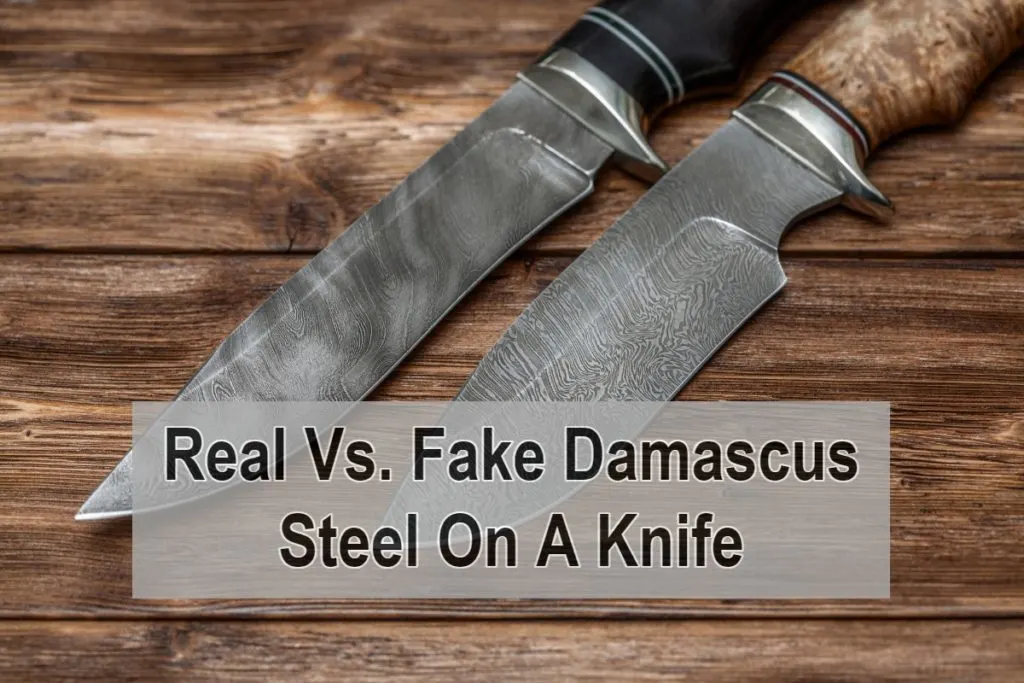
What Is Damascus Steel?
If we are discussing the differences between real and fake Damascus steel, a good place to start would be to understand what Damascus steel is to identify the fake from the real thing.
Damascus steel has an ancient history, and there is some contention about how the steel came to be known by the term Damascus. Some say it is named after the Syrian city where the steel was sold at the time or after fabrics from the same region that exhibited similar patterns.
Other sources claim the term comes from a blacksmith in ancient times who specialized in crucible steel, which is how Damascus steel was originally made.
Damascus steel can be traced back in history to the first millennium and was the sought-after steel for making swords. In the era when wars were fought with swords, Damascus steel swords had a reputation for being harder, more flexible, sharper, and able to hold an edge for longer than swords made from iron. able to hold a sharper edge.
What Does Damascus Steel Look Like?
Damascus steel is easily distinguished by its wavy, swirly patterned design resembling ripples on water, and in the modern context, Damascus steel is valued for its strength as well as its beauty.
While historical Damascus steel was made by melting the metals in a crucible, producing Wootz steel ingots for forging, modern Damascus is created by hot forge-welding multiple steel types together to form a molecular bond between the steel layers.
This method of making Damascus steel allows for more elaborate patterns in the steel. The patterns are formed when the steel stock with multiple layers of varying metal is cut, re-stacked, and forge-welded back together.
The pattern created in the steel will be determined by the orientation in which the layers are stacked and welded together.
Another Damascus pattern is twist Damascus, where the metal stock is heated to the point the steel becomes malleable. One end of the hot steel is placed in a vice, and the blacksmith twists the other end to create the pattern through the steel.
When a knife or sword is made from Damascus steel, the pattern of the steel layers is not always immediately visible on the blade.
The pattern is revealed in the steel when it is acid-etched using a mild acid, usually ferric chloride, which darkens the different metals in the steel to varying degrees. The varying shades of each layer of steel in Damascus highlight the patterns, revealing its beauty.
Modern Damascus steel has become an art form, resulting in patterns called feathered Damascus, ladder, twist, raindrop, and spiderweb.
How Is Fake Damascus Made?
Real Damascus steel is time-consuming to make and produces certain qualities in the steel that bring advantages to the blade as the end product.
True Damascus blades demand a higher price because of the time to create the steel, the quality of the steel in Damascus, and the increased durability of the blade.
Unscrupulous knifemakers and suppliers seek to capitalize on the popularity of Damascus steel knives by disguising a single steel blade with Damascus-like patterns. They then charge a higher price for the fake Damascus and essentially cheat the consumer by supplying an inferior product and false marketing.
Fake Damascus is created by acid etching or laser etching standard high-carbon steel with patterns that mimic the look of true Damascus steel.
The laser or acid etching intensity is varied to produce differing light and dark lines in the steel that realistically mimic the patterns produced in true Damascus steel.
TIP: Japan has a long history in the production of steel and manufacturing of superior quality blades. Check out the best steels for Japanese knives in the article below:
Japanese Knives Steel Types (Complete List with Explanation)
How To Tell If My Knife Is Real Damascus
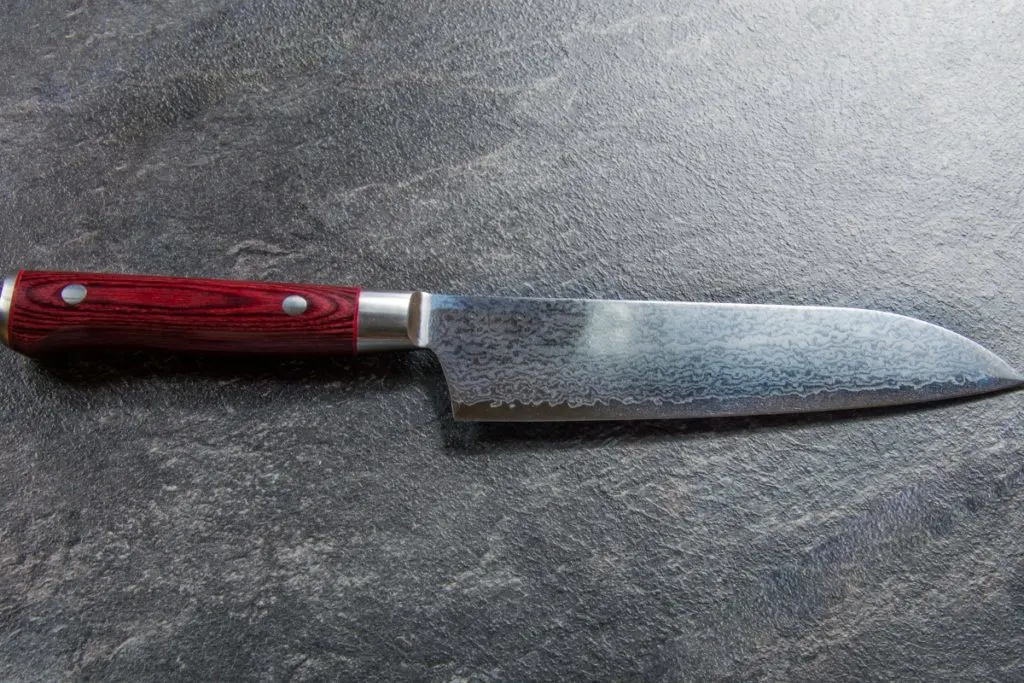
Many fake Damascus knife makers get away with their deception because it is difficult to tell the difference between real and fake Damascus.
The difficulty in telling the difference between real and fake Damascus comes from the fact that the best way to test for authenticity requires defacing the knife and using products that most people do not have readily on hand.
The following methods can be used to give you an idea of whether the Damascus steel is genuine or not. However, the results are not always conclusive on their own and require a combination of tests to confirm authenticity.
The following tests can give you clues that you can use to guide you on whether your Damascus blade is genuine or fake.
1. Well-known Knife Brands
The brand or name of the manufacturer says a lot about the quality of work and materials included in the production of the knife. Brands with a name known for quality knives will not entertain using fake Damascus at the risk of destroying their reputation in the market.
Buying a Damascus steel knife from a well-known knife brand and a reputable supplier will generally ensure that the knife you receive is made from genuine Damascus steel.
However, the black market industry is known for creating knock-off copies of reputable brands. In these cases, the supplier of the product is a key factor and the product’s price point.
If the brand is well-known, but the price sounds too good to be true, then you are likely dealing with a knock-off, and Damascus is likely to be fake.
If you can hold the knife in your hand, look for a knife’s overall design to be more premium, with quality workmanship and attention to detail in all aspects of the knife.
TIP: If you are interested in checking out the best Damascus steel knives from well-known brands, we recommend trying to check knives made by Yoshihiro or Sakai Company, both of which are traditional Japanese manufacturers. You can find their knives by clicking here and here (Amazon links).
2. Uniform Damascus Steel Patterns
The folds or lines in Damascus steel patterns are not simply lines but layers of steel that run through the material.
Consequently, these lines should not come to abrupt ends and have gaps, jagged edges, and other visual discrepancies in the pattern.
A genuine Damascus steel knife will have a uniform and contiguous pattern of folds running all the way through the steel.
TIP: A common question around the internet is, what is the easiest knife to sharpen? Find out the complete list with an explanation in the article below:
List of The Easiest Knife Steels To Sharpen (With Examples)
3. The Damascus Pattern Is Present All Through The Knife
As mentioned previously, the pattern in the Damascus steel represents a layer of metal that should persist all the way through the steel.
This means the pattern should be visible on all parts of the knife, the sides of the steel, the spine, the bolster, the tang, and the butt. If the pattern does not follow through on these parts of the knife, then the steel may not be authentic Damascus.
However, some knife manufacturers polish the knife’s spine, bolster, and butt, which buffs the steel to a shine that masks the Damascus pattern. The contrast between the steel layers is lost if all the layers are polished to the same luster.
If you angle the knife to catch the light in different ways, you may detect the Damascus pattern in the steel, but the level of polishing of the steel will determine this.
The polishing of certain parts of the knife is done to enhance the visual appeal of the knife, and it is, therefore, not conclusive proof that the Damascus is fake, but it should cause you to investigate further.
4. Unnatural Damascus Designs
Damascus pattern lines are natural, flowing lines that resemble ripples on water. If the pattern on the steel looks unnatural or is designed to look like a known object, such as a skull, lightning bolt, or similar fashionable design, the Damascus steel is likely fake.
Designs that are extremely intricate or too symmetrical are also indicators that the pattern may be artificially placed on the steel.
5. The Price Of The Damascus Steel Knife
Damascus steel blades are typically more expensive than standard high-carbon steel or stainless steel blades.
A low price is certainly not a clear-cut determination that the Damascus steel is fake, but if the sale price is significantly lower than what you would expect to pay for a Damascus steel knife, it should raise some warning flags.
The old principle, “If the deal sounds too good to be true, then it usually is,” is a good yardstick when evaluating the cost of a knife claimed to be made with Damascus steel.
Even if Damascus is a genuine product, if the knife is being offered and a ridiculously low price, it has to make you wonder about the quality of the materials and manufacture of the rest of the knife.
6. The Damascus Pattern Can Be Restored With Etching
A test that you can perform to give conclusive results as to the authenticity of the Damascus steel is an etch test.
Not everyone would want to perform this test, as it involves taking actions that can mar the finish on the knife. The test also uses products that not every person will have in their household.
The equipment needed to perform the test is fine grit sandpaper, ferric chloride, and water. Most people will have access to water and sandpaper, but ferric chloride is the etching acid used to bring out the Damascus pattern and is typically only used by knife makers.
The process of testing the steel for authenticity is quite simple. Use the sandpaper to abrade the Damascus pattern off a small section of the steel. If the knife can be disassembled, you could take the knife apart and perform this test on a piece of steel that is not visible when the knife is assembled.
Dip the section of the steel that has been sanded in the ferric chloride solution. The time the steel must be submerged does not need to be long. A 30-second to 1-minute duration in the solution will be enough to see the pattern begin to emerge if the steel is genuine.
Wash the area in water after removing it from the acid, or sprinkle some baking soda on the site to neutralize the etchant and rinse the blade.
If the knife is made from genuine Damascus steel, the pattern will return to the section of the metal that was sanded. If the pattern does not return after the etch, but the patch seems to be a uniformly dark color, then the steel is fake Damascus.
TIP: There are so many knife steels available that it becomes confusing to choose which is the best steel for a particular knife. Check out the complete list in the article below:
Full List: Best Knife Steels For Different Knives (+ Why)
Is Damascus Steel Supposed To Be Smooth
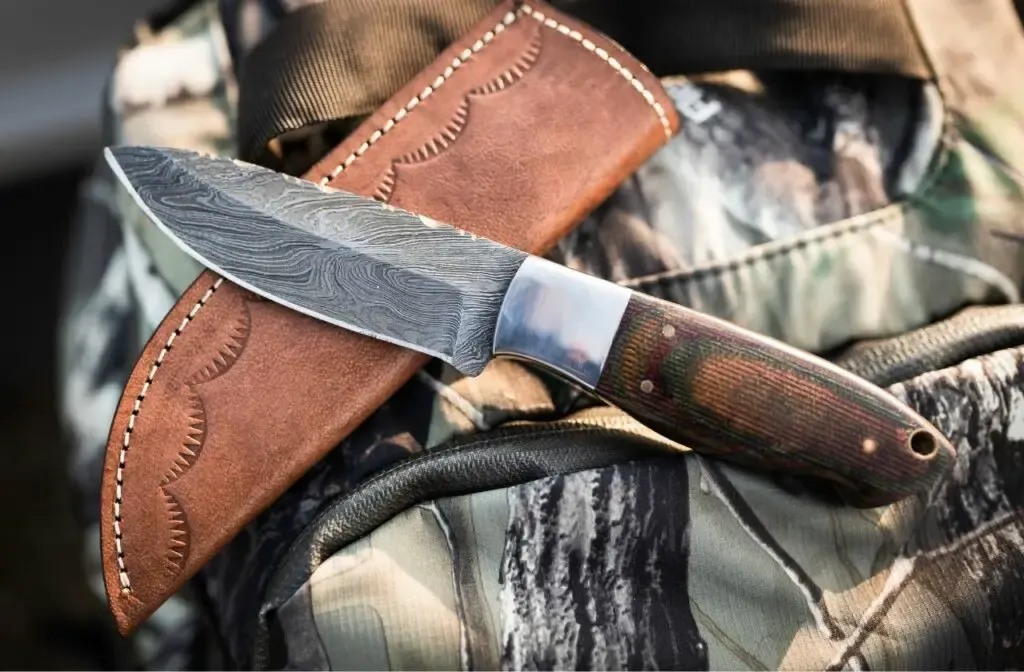
It would be a logical thought to expect the layered Damascus steel to have a texture that can be felt on the skin or by running a fingernail across the blade’s surface. This test would be great if it worked, but the fold and boundaries between the steel layers can generally not be felt.
The blade steel is usually sanded smooth to give an even finish across the surface of the steel. This sanding process removes any ridges between the layers of steel, making them imperceptible to the touch.
In some rough-finished Damascus, the ridges between the layers can be detected by running your fingernail across the steel’s surface.
In some cases, fake Damascus can have raised boundaries between the layers where the etching acid has removed some of the softer metal on either side of a harder layer of steel.
The possibility of both fake and genuine Damascus steel having texture means that this test is not viable for determining authenticity.
If you are interested in buying some of the best whetstones for sharpening your Damascus steel knives, you can find them in the table below:
| Usage | Grit Type | Best Option |
|---|---|---|
| Fixing stone | 320 grit | Shapton Kuromaku 320 |
| Establishing the Edge | 400 grit | Naniwa Chosera 400 |
| Sharpening Stone | 600 grit | Naniwa Chosera 600 |
| Sharpening Stone | 800 grit | Naniwa Chosera 800 |
| Finishing Stone | 1000 grit | Suehiro CERAX |
| Polishing Stone | 2000 grit | Shapton Kuromaku 2000 |
| Polishing Stone | 5000 grit | Shapton Kuromaku 5000 |
| Extra Polishing Stone | 8000 grit | Shapton Kuromaku 8000 |
| Mirror Polishing Stone | 12000 grit | Shapton Kuromaku 12000 |
How To Tell Fake Damascus Steel Knife
Buying a Damascus knife always presents the concern of whether the Damascus steel is authentic or fake.
One of the first warning flags that the knife may not be genuine Damascus is the purchase price of the knife. Damascus steel is expensive because of the labor-intensive processes of making steel, especially the more complex patterns.
Selecting a Damascus knife from a well-known knife maker or brand is a good way to ensure you are purchasing a knife made from true Damascus steel.
Checking the Damascus pattern and ensuring it follows through the steel on all parts of the knife, including the spine, bolsters, and tang, is another way to check whether the knife is the real deal.
Even if all parts of the knife are not etched, if you hold the knife up to the light at different angles, you should be able to make out faint continuations of the Damascus pattern.
Examine the Damascus pattern on the knife to make sure the pattern looks natural and unbroken across the steel’s surface. Unnatural patterns generally indicate the pattern is fake rather than an integral part of the steel.
TIP: Rust is a well-known problem on any knife in the kitchen, which requires maintenance and a prevention strategy. Find out how to prevent rust on kitchen knives in the article below:
6 Proven Ways On How To Prevent Rust On Kitchen Knives
Difference Between Real and Fake Damascus Knife
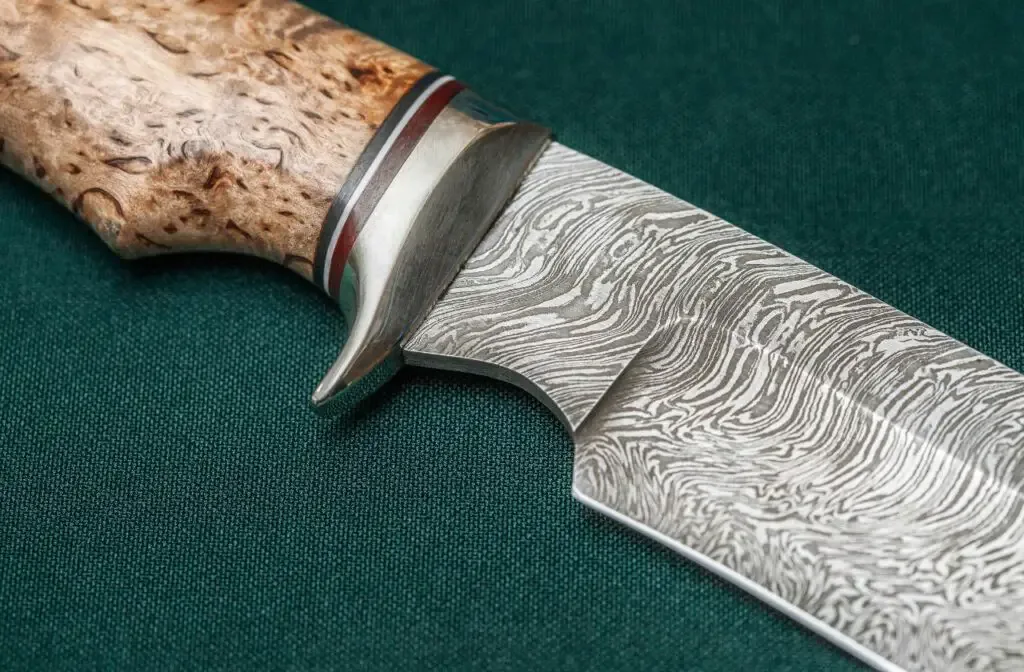
It is very difficult to tell the difference between real and fake Damascus knives, especially if the etching is done with lasers.
Cheap fake Damascus knock-offs will show distinctive wear in the pattern on the steel with the normal use of the knife, which should not happen with authentic Damascus steel.
The only real definitive test that will show the difference between real and fake Damascus steel knives is the acid etch test. Unfortunately, the fakes are so well manufactured due to modern technology that this drastic step is the only true test.
Rubbing a part of the knife blade with high grit sandpaper to remove the Damascus pattern and dipping it in ferric chloride is the only definitive test. If the Damascus pattern returns after the etch, the knife is made from genuine Damascus steel.
Damascus Steel vs. Other Popular Knife Materials
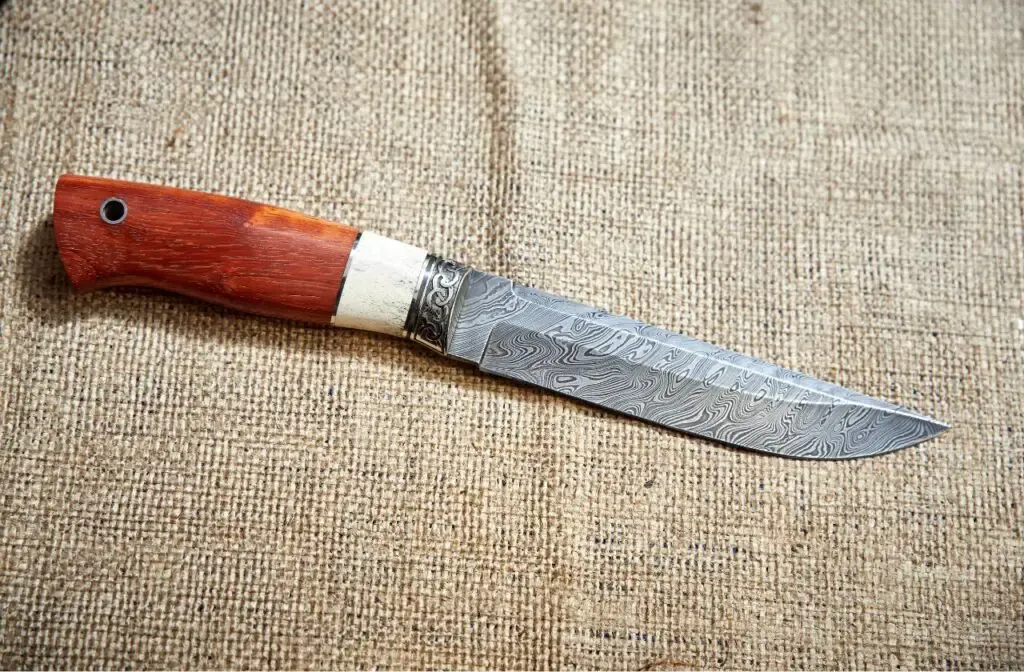
When choosing a knife, the material of the blade is a critical factor. Real Damascus steel is often compared with other popular knife materials. Here’s a detailed comparison highlighting their differences, strengths, weaknesses, and uses.
Real Damascus Steel
Composition: Damascus steel is known for its distinctive wavy pattern, created by forge-welding multiple layers of steel (usually a mix of high-carbon and stainless steel) and repeatedly folding them.
Strengths:
Aesthetic Appeal: The unique patterns make each Damascus knife visually striking and unique.
Edge Retention: Good quality Damascus steel holds a sharp edge well.
Durability: The layering process imparts strength, making these knives durable.
Weaknesses:
Price: The labor-intensive process makes Damascus steel knives generally more expensive.
Maintenance: Requires regular maintenance to prevent corrosion, especially in high-carbon variants.
Inconsistency: Quality can vary significantly depending on the manufacturer.
Uses: Ideal for culinary enthusiasts and collectors. Great for slicing and precision cutting due to their sharpness.
Stainless Steel
Composition: Made from an alloy of iron, carbon, and at least 10.5% chromium. It may also contain other elements like nickel and molybdenum.
Strengths:
Corrosion Resistance: High resistance to rust and staining.
Low Maintenance: Easier to care for compared to high-carbon steels.
Affordability: Generally less expensive than Damascus steel.
Weaknesses:
Edge Retention: Tends to lose its edge faster than high-carbon steels.
Sharpening Difficulty: Can be harder to sharpen due to its hardness.
Uses: Widely used in kitchen knives, pocket knives, and everyday utility knives.
High-Carbon Steel
Composition: An alloy of iron and carbon, with a higher carbon content than stainless steel.
Strengths:
Edge Retention: Excellent at holding a sharp edge.
Sharpness: Can be sharpened to a very fine edge.
Strength: Generally stronger and harder than stainless steel.
Weaknesses:
Corrosion Prone: Requires regular oiling and maintenance to prevent rust.
Brittleness: Higher carbon content can make the steel more brittle.
Uses: Preferred in professional chef knives, hunting knives, and cutting tools where sharpness is paramount.
Ceramic
Composition: Made from zirconium dioxide, hardened through a heating process.
Strengths:
Sharpness: Retains sharpness longer than most metal knives.
Corrosion Resistance: Impervious to acids, salts, and rust.
Lightweight: Easier to handle due to its light weight.
Weaknesses:
Fragility: Prone to chipping or breaking if dropped.
Sharpening Difficulty: Requires specialized tools for sharpening.
Uses: Best for slicing fruits, vegetables, and boneless meats. Not recommended for heavy-duty tasks.
Titanium
Composition: Made from a titanium alloy, often mixed with other metals like aluminum and vanadium.
Strengths:
Weight: Lighter than most steel knives.
Corrosion Resistance: Highly resistant to corrosion and wear.
Flexibility: More flexible than steel, reducing the likelihood of chipping.
Weaknesses:
Edge Retention: Does not hold an edge as well as steel.
Cost: More expensive due to the cost of titanium.
Uses: Popular in diving knives and pocket knives, especially where weight and corrosion resistance are important.
Each material offers unique benefits and drawbacks. Damascus steel stands out for its beauty and sharpness, making it a favorite among enthusiasts and chefs who value both aesthetics and performance.
Stainless steel and high-carbon steel offer practical, everyday solutions with varying degrees of maintenance needs. Ceramic and titanium provide niche advantages in specific environments.
The choice ultimately depends entirely on the intended use, personal preference, and maintenance willingness.
Conclusion
It is not a good feeling to realize that you have paid good money for a Damascus steel product only to realize you have been swindled by deceptive and fraudulent marketing.
The difficulty in telling the difference between fake and genuine Damascus steel increases the risk of the consumer being duped into buying an inferior product. Close inspection of the knife and knowing what to look for help to find clues that may give a clear answer.
TIP: We have some pro tips to help you keep your Damascus knives in pristine condition. Check out the best tips on taking care of and cleaning your Damascus steel knives in the article below:
PRO Tips: Taking Care & Cleaning Of Damascus Steel Knives

